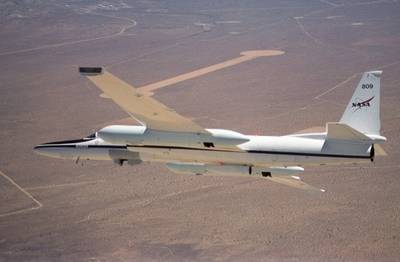Sat, Jul 16, 2005
Nasa's Tropical Cloud Systems And Processes Mission In Costa
Rica
 In the wake of Hurricane Dennis,
NASA and the National Oceanic and Atmospheric Administration (NOAA)
are busy studying data gathered during the early days of the
hurricane that threatened much of the southern Atlantic and Gulf of
Mexico.
In the wake of Hurricane Dennis,
NASA and the National Oceanic and Atmospheric Administration (NOAA)
are busy studying data gathered during the early days of the
hurricane that threatened much of the southern Atlantic and Gulf of
Mexico.
Researchers conducted their second coordinated flight to study
Tropical Storm Dennis on the evening of July 6. The ER-2 overflew
the developing eye and "rain bands" of the tropical storm using
coordinates relayed by the TCSP science team monitoring satellite
imagery on the ground. The ER-2, which flew at 65,000 feet, was
joined a few hours later by the NOAA P-3 Orion, flying at 14,000
feet. During the mission, the National Hurricane Center upgraded
Tropical Storm Dennis to Hurricane Dennis at Category 1
intensity.
The NASA and NOAA planes flew coordinated passes over the eye of
the storm for more than an hour. Both aircraft monitored
precipitation structures as the eye became more tightly concentric,
and rain bands increased in intensity with each pass. The P-3 Orion
continued to monitor the storm's eye wall and rain band development
for several more hours after the ER-2 returned to base, making five
passes over the eye. At one point, the storm pressure dropped 12
millibars in a two-hour period -- equivalent to the amount that a
garden-variety low pressure system over the United States may
intensify in about 24 hours.
The TCSP missions to document developing tropical cyclones are
providing rare datasets that will help unravel the mysteries about
why so few tropical weather disturbances intensify into
full-fledged hurricanes. For instance, "rapid deepening" -- a
phenomenon in which the minimum sea-level pressure of a tropical
cyclone drops by 1.75 millibars per hour, or 42 millibars in 24
hours -- is still poorly understood and is not captured well by
hurricane forecast models. In the case of Dennis, the data captured
exceptionally rapid deepening of the storm's central pressure, as
well as documenting the eye in the process of closing off into a
complete circle.

The 28-day TCSP mission is sponsored by NASA's Science Mission
Directorate at NASA Headquarters in Washington. The primary goal of
the mission is to document "cyclogenesis" in action -- the
interaction of temperature, humidity, precipitation, wind and air
pressure that creates ideal birthing conditions for tropical
storms, hurricanes and related phenomena.
More News
Aero Linx: Model Aeronautical Association of Australia MAAA clubs are about fun flying, camaraderie and community. For over 75 years, the MAAA has been Australia’s largest fl>[...]
Touchdown Zone Lighting Two rows of transverse light bars located symmetrically about the runway centerline normally at 100 foot intervals. The basic system extends 3,000 feet alon>[...]
“Discovery and innovation are central to our mission at Virgin Galactic. We’re excited to build on our successful record of facilitating scientific experiments in subor>[...]
How To Get A Story On Aero-TV News/Feature Programming How do I submit a story idea or lead to Aero-TV? If you would like to submit a story idea or lead, please contact Jim Campbel>[...]
Student Pilot Reported That During Rotation, “All Of A Sudden The Back Of The Plane Kicked To The Right..." Analysis: The student pilot reported that during rotation, “>[...]
 ANN's Daily Aero-Linx (05.02.24)
ANN's Daily Aero-Linx (05.02.24) ANN's Daily Aero-Term (05.02.24): Touchdown Zone Lighting
ANN's Daily Aero-Term (05.02.24): Touchdown Zone Lighting Aero-News: Quote of the Day (05.02.24)
Aero-News: Quote of the Day (05.02.24) ANN FAQ: Contributing To Aero-TV
ANN FAQ: Contributing To Aero-TV NTSB Final Report: Cirrus Design Corp SR20
NTSB Final Report: Cirrus Design Corp SR20




